It's All Come Together
 August is the best month to see the plantings in this botanical garden as their designers imagined. I remember the plants when they were bedding plant size. Back then, the spaces of bare ground between plants made it hard for me to visualize how the mature plots would turn out. No matter how hard I looked at the fledgling summer plants just after they were put in, I couldn’t use my mind’s eye to see them as would look now in the lushness of August. It takes a deep understanding of horticulture along with an artist’s eye to choose the right plant combinations and then to be able to picture them after time and nurturing and luck have done their work.
August is the best month to see the plantings in this botanical garden as their designers imagined. I remember the plants when they were bedding plant size. Back then, the spaces of bare ground between plants made it hard for me to visualize how the mature plots would turn out. No matter how hard I looked at the fledgling summer plants just after they were put in, I couldn’t use my mind’s eye to see them as would look now in the lushness of August. It takes a deep understanding of horticulture along with an artist’s eye to choose the right plant combinations and then to be able to picture them after time and nurturing and luck have done their work.
 The people who want to raise giant pumpkins usually plant Atlantic Giants. Atlantic Giant seeds were developed by the late Howard Dill, once described as a “full time farmer and a part-time mad scientist.” He was a self-taught geneticist and an avid tinkerer. He bred and cross-bred pumpkin seeds for years and experimented with techniques of raising them. His aim was to grow the biggest pumpkin in the world. Dill won his first “weigh-off” in 1979 with a pumpkin that weighed 432 pounds. That was just the beginning. His pumpkins grew heftier, he won more contests, and in the process, he whetted an international appetite for growing giant pumpkins. Last year the weigh-off was won by a 2032 pound pumpkin that’s shaped like a deflated holiday lawn ornament. This Atlantic Giant growing in Kemper Center veggie gardens won’t set any records, but will be interesting to watch as it grows on.
The people who want to raise giant pumpkins usually plant Atlantic Giants. Atlantic Giant seeds were developed by the late Howard Dill, once described as a “full time farmer and a part-time mad scientist.” He was a self-taught geneticist and an avid tinkerer. He bred and cross-bred pumpkin seeds for years and experimented with techniques of raising them. His aim was to grow the biggest pumpkin in the world. Dill won his first “weigh-off” in 1979 with a pumpkin that weighed 432 pounds. That was just the beginning. His pumpkins grew heftier, he won more contests, and in the process, he whetted an international appetite for growing giant pumpkins. Last year the weigh-off was won by a 2032 pound pumpkin that’s shaped like a deflated holiday lawn ornament. This Atlantic Giant growing in Kemper Center veggie gardens won’t set any records, but will be interesting to watch as it grows on.
 The Corpse Flower has finished blooming, but there’s another noxious smell to take its place. Get over to the far side of Japanese Garden. Gases from rotting vegetation at the bottom of the pond are leaking to surface filling the air with odors that smell like rotten eggs combined with a teen’s gym socks and a musky basement. Apart from the smell though, the view on the far side of pond is splendid.
The Corpse Flower has finished blooming, but there’s another noxious smell to take its place. Get over to the far side of Japanese Garden. Gases from rotting vegetation at the bottom of the pond are leaking to surface filling the air with odors that smell like rotten eggs combined with a teen’s gym socks and a musky basement. Apart from the smell though, the view on the far side of pond is splendid.
 An early warning that fall is on the way.
An early warning that fall is on the way.
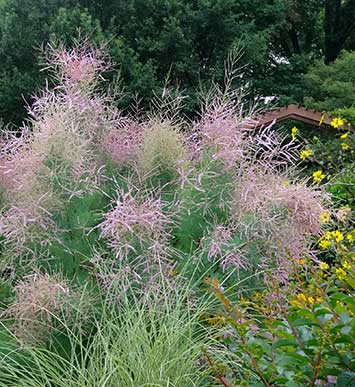 This botanical garden has several Tamarisks in bloom just now. This one is blooming in Kemper Home Gardens. When in flower the Tamarisk look like Astilbes that have mutated into giant shrubs that throw off pink plumes wily-nilly. Here in this botanical garden in the Midwest, they’re showy and ornamental. Elsewhere Tamarisks are the arch-enemy.
This botanical garden has several Tamarisks in bloom just now. This one is blooming in Kemper Home Gardens. When in flower the Tamarisk look like Astilbes that have mutated into giant shrubs that throw off pink plumes wily-nilly. Here in this botanical garden in the Midwest, they’re showy and ornamental. Elsewhere Tamarisks are the arch-enemy.
In Arizona along the Colorado River, thousands of Tamarisk trees grow. They grow there because they are thirsty trees. Some claim each tree consumes 200 gallons of water a day from the river – water that could be used to irrigate farm land or to serve cities in the Southwest.
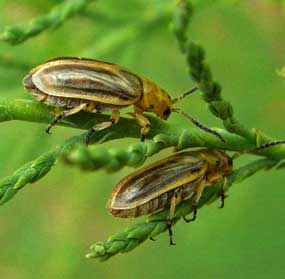 To control the trees the United States Department of Agriculture released the tamarisk beetle, an insect that destroys the trees by feeding on their foliage.
They released the beetle in Colorado in 2001. Now the beetles have spread to Arizona where they’re feeding on trees leaving dead gray skeletons behind. Opponents of using beetles as a way to kill Tamarisk trees are concerned about what will happen after the beetles fell the last Tamarisk.
To control the trees the United States Department of Agriculture released the tamarisk beetle, an insect that destroys the trees by feeding on their foliage.
They released the beetle in Colorado in 2001. Now the beetles have spread to Arizona where they’re feeding on trees leaving dead gray skeletons behind. Opponents of using beetles as a way to kill Tamarisk trees are concerned about what will happen after the beetles fell the last Tamarisk.
 These plants grow fast. From seemingly nothing a few weeks ago they’re now about three feet tall. Labeled Silver Spurflower (Plectranthus argentatus), the plant continues to get taller, but has yet to flower as would be expected from its name. Fine Gardening magazine says the Spurflower is grown for its velvety fuzzy silvery leaves, not its flowers. On its website this botanical garden describes its flowers “somewhat showy,” but of secondary interest. Still I'd like to see them flower before the frost or the seasonal replanting takes them. Any plant with name Spurflower ought to at least flower sometime.
These plants grow fast. From seemingly nothing a few weeks ago they’re now about three feet tall. Labeled Silver Spurflower (Plectranthus argentatus), the plant continues to get taller, but has yet to flower as would be expected from its name. Fine Gardening magazine says the Spurflower is grown for its velvety fuzzy silvery leaves, not its flowers. On its website this botanical garden describes its flowers “somewhat showy,” but of secondary interest. Still I'd like to see them flower before the frost or the seasonal replanting takes them. Any plant with name Spurflower ought to at least flower sometime.
Cut a little off the top — the bottom too.
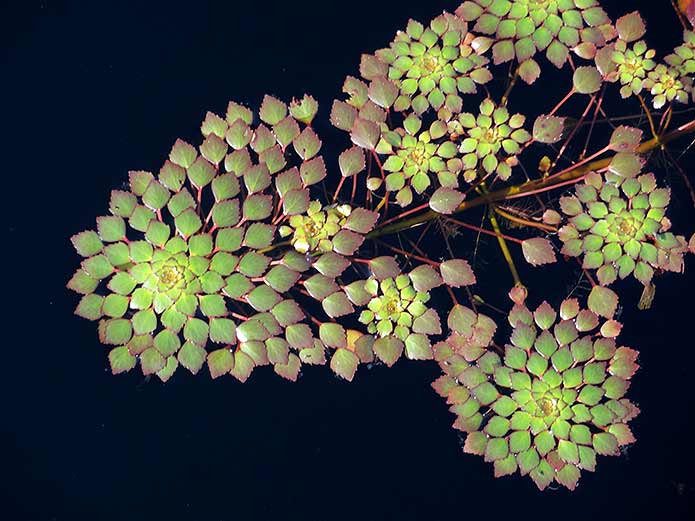 Do see this: the Mosaic plants (Ludwigia Sedioides) spreading out on the pond in the George Washington Carver Garden. Stunning sight against the water dyed black
Do see this: the Mosaic plants (Ludwigia Sedioides) spreading out on the pond in the George Washington Carver Garden. Stunning sight against the water dyed black
 A second Corpse Flower (Amorphophallus titanum) has bloomed and faded. Somewhat jaded by having two rarities bloom in such close succession, I didn’t follow its coming or going very carefully. Neither did the media. The first one — ‘Izzy’ — was tracked with great hoopla on the evening newscasts and in the newspaper. This one, dubbed ‘Hunter’ went unnoticed. Hunter bloomed the night of July 28th. While it was at peak bloom, its care takers cut a rectangular opening in its base to pollinate the female flowers at the base of the plant. The Garden’s press release didn’t say where the pollen came from (perhaps frozen pollen collected from Izzy’s male flowers?), but it had to come from another flower because Titans avoid self-pollination. This morning the incision is on display. The reddish female flowers are on the bottom; the faded yellow males are on top. If the insemination was successful the red flowers will develop into bright scarlet fruits and will raise up from the base as the other parts of the flower wither away. In the wild, the red fruit would be eaten by birds and the seeds dispersed in their droppings.
A second Corpse Flower (Amorphophallus titanum) has bloomed and faded. Somewhat jaded by having two rarities bloom in such close succession, I didn’t follow its coming or going very carefully. Neither did the media. The first one — ‘Izzy’ — was tracked with great hoopla on the evening newscasts and in the newspaper. This one, dubbed ‘Hunter’ went unnoticed. Hunter bloomed the night of July 28th. While it was at peak bloom, its care takers cut a rectangular opening in its base to pollinate the female flowers at the base of the plant. The Garden’s press release didn’t say where the pollen came from (perhaps frozen pollen collected from Izzy’s male flowers?), but it had to come from another flower because Titans avoid self-pollination. This morning the incision is on display. The reddish female flowers are on the bottom; the faded yellow males are on top. If the insemination was successful the red flowers will develop into bright scarlet fruits and will raise up from the base as the other parts of the flower wither away. In the wild, the red fruit would be eaten by birds and the seeds dispersed in their droppings.
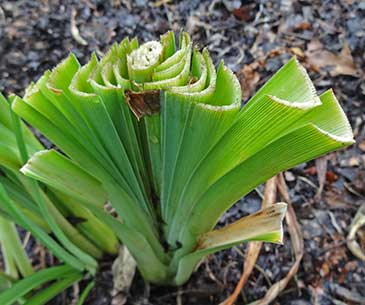 Another cutting of note: This year for the first time I can remember, all of the daylily leaves have been trimmed. They usually get a trim much later in the season after all of the late bloomers have had their turn. It seems odd to see all of the foliage gone while the some scapes of flowering daylilies filled with blooming flowers poke up from naked bases. Why cut back so early? I found that while opinions vary on the practice, most say to leave the leaves. If you cut back too soon you weaken the plants. The leaves provide food for the roots to strengthen for the winter. Cut before the leaves brown or before the first frost and you get weaker plants and fewer flowers next year. A minority opinion says to cut after blooming to avoid have to look at ratty-looking plants. They say that even if you cut the leaves just after blooming, new leaves will still have chance to grow back before a freeze hits. No one says to cut while daylilies are still blooming as the botanical garden has done. We will see.
Another cutting of note: This year for the first time I can remember, all of the daylily leaves have been trimmed. They usually get a trim much later in the season after all of the late bloomers have had their turn. It seems odd to see all of the foliage gone while the some scapes of flowering daylilies filled with blooming flowers poke up from naked bases. Why cut back so early? I found that while opinions vary on the practice, most say to leave the leaves. If you cut back too soon you weaken the plants. The leaves provide food for the roots to strengthen for the winter. Cut before the leaves brown or before the first frost and you get weaker plants and fewer flowers next year. A minority opinion says to cut after blooming to avoid have to look at ratty-looking plants. They say that even if you cut the leaves just after blooming, new leaves will still have chance to grow back before a freeze hits. No one says to cut while daylilies are still blooming as the botanical garden has done. We will see.
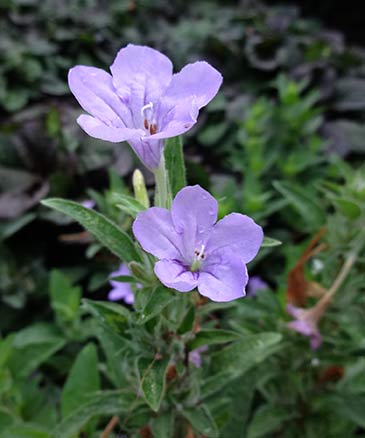 Not many wildflowers have crossed-over from fields to home gardens. Those that have like the Purple Cone Flower (Echinacea), have had to be styled into named varieties that augment the size of their cones or that change the color of their petals to something other than drab purple. One flower that has managed to make the cross-over from roadside ditches and stony outcroppings to sunny garden rock gardens is the Wild Petunia (Ruellia humilis). As far as I’ve been able to determine, no one has yet developed a new and improved variety of this native ground creeper. This botanical garden uses Wild Petunias in its sunny Heckman Rock Garden. They’re planted around the stepping stones leading down the path probably because they’re tough enough to bounce back from a few missteps and they bloom from late spring to frost. Wild Petunia flowers resemble petunias, but beyond the name they have in common, they aren’t related botanically.
Not many wildflowers have crossed-over from fields to home gardens. Those that have like the Purple Cone Flower (Echinacea), have had to be styled into named varieties that augment the size of their cones or that change the color of their petals to something other than drab purple. One flower that has managed to make the cross-over from roadside ditches and stony outcroppings to sunny garden rock gardens is the Wild Petunia (Ruellia humilis). As far as I’ve been able to determine, no one has yet developed a new and improved variety of this native ground creeper. This botanical garden uses Wild Petunias in its sunny Heckman Rock Garden. They’re planted around the stepping stones leading down the path probably because they’re tough enough to bounce back from a few missteps and they bloom from late spring to frost. Wild Petunia flowers resemble petunias, but beyond the name they have in common, they aren’t related botanically.
New Sightings: Purple Tomatoes and a Ruby Shrub
 Shard of sycamore bark
Shard of sycamore bark
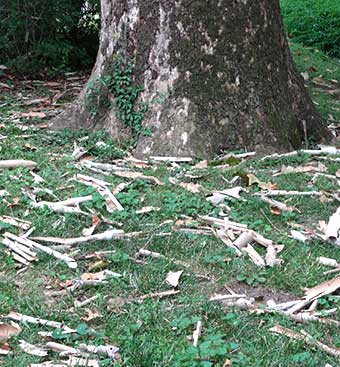 Sycamore trees get lumped with sweetgums, silver maples, and buckeyes as dirty trees. They all have droppings that need tending. This time of year, it’s the sycamores. All over this botanical garden, the sycamore trees are shedding sheets of their brittle outer bark leaving behind the white blotches that look so striking against a blue winter sky. I think the number and size of the sheets are larger than they have been in years past. Maybe the record cold of last winter loosened more of the bark than usual.
Sycamore trees get lumped with sweetgums, silver maples, and buckeyes as dirty trees. They all have droppings that need tending. This time of year, it’s the sycamores. All over this botanical garden, the sycamore trees are shedding sheets of their brittle outer bark leaving behind the white blotches that look so striking against a blue winter sky. I think the number and size of the sheets are larger than they have been in years past. Maybe the record cold of last winter loosened more of the bark than usual.
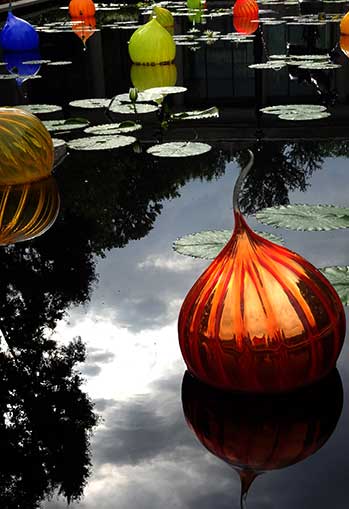 It's was a perfect day for looking. With a gray overcast sky, this reflecting pond filled with tropical waterlilies and Dale Chihuly’s glass walla walla onion balls – both in an assortment of summer colors – was a good place to pause a bit.
It's was a perfect day for looking. With a gray overcast sky, this reflecting pond filled with tropical waterlilies and Dale Chihuly’s glass walla walla onion balls – both in an assortment of summer colors – was a good place to pause a bit.
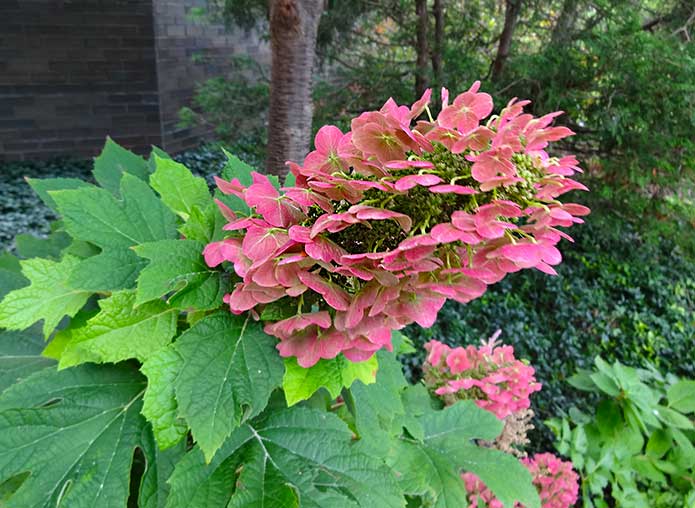 I saw this Oakleaf Hydrangea just outside the Kemper Garden Center. It’s a variety called ‘Ruby Slippers.’ It looks like a hydrangea that’s been to obedience school. It has a well-mannered symmetrical shape and petite-sized leaves to match. Yet the length and fullness of its panicles of burnished red flowers are anything but petite. ‘Ruby Slippers’ has plenty of impressive nine-inch panicles that jut out from its foliage. The hydrangea was developed by the National Arboretum’s shrub breeding program. When mature, the Arboretum says it will be just three feet tall and spread only five feet. ‘Red Slippers’ was under development for more than a decade, but it’s only been available for a few years. Already some garden magazines have dubbed it as the must have shrub for planting in places where the large, free-form oakleaves won’t fit.
I saw this Oakleaf Hydrangea just outside the Kemper Garden Center. It’s a variety called ‘Ruby Slippers.’ It looks like a hydrangea that’s been to obedience school. It has a well-mannered symmetrical shape and petite-sized leaves to match. Yet the length and fullness of its panicles of burnished red flowers are anything but petite. ‘Ruby Slippers’ has plenty of impressive nine-inch panicles that jut out from its foliage. The hydrangea was developed by the National Arboretum’s shrub breeding program. When mature, the Arboretum says it will be just three feet tall and spread only five feet. ‘Red Slippers’ was under development for more than a decade, but it’s only been available for a few years. Already some garden magazines have dubbed it as the must have shrub for planting in places where the large, free-form oakleaves won’t fit.
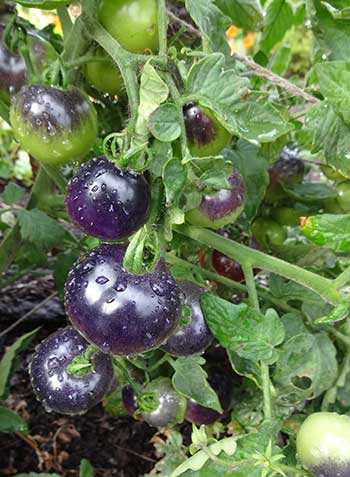 When I saw this ripening tomato named ‘Indigo Rose,’ I thought that it was some kind of heritage or heirloom tomato. It’s not. It’s a brand new variety. ‘Indigo Rose’ was bred at Oregon State University. There they have a program to develop new tomatoes that have high levels of anthocyanin, a naturally occurring antioxidant found in purple fruits and vegetables like blueberries and eggplant skins. ‘Indigo Rose’ gets its anthocyanin from its skin – the darkest of all purple skinned tomatoes. It was developed by crossing two wild specie tomatoes, so it has no genetically modified genes and will breed true to form from its own seeds. What do the two-inch globes look like inside and how do they taste? Since botanical gardens are for looking, not picking, I’ll never know. Those who have seen them report that they’re red inside. As to taste, opinions vary from “unique and fabulous” to “the taste is how I think grass clippings probably taste.”
When I saw this ripening tomato named ‘Indigo Rose,’ I thought that it was some kind of heritage or heirloom tomato. It’s not. It’s a brand new variety. ‘Indigo Rose’ was bred at Oregon State University. There they have a program to develop new tomatoes that have high levels of anthocyanin, a naturally occurring antioxidant found in purple fruits and vegetables like blueberries and eggplant skins. ‘Indigo Rose’ gets its anthocyanin from its skin – the darkest of all purple skinned tomatoes. It was developed by crossing two wild specie tomatoes, so it has no genetically modified genes and will breed true to form from its own seeds. What do the two-inch globes look like inside and how do they taste? Since botanical gardens are for looking, not picking, I’ll never know. Those who have seen them report that they’re red inside. As to taste, opinions vary from “unique and fabulous” to “the taste is how I think grass clippings probably taste.”
Izzy's Gone
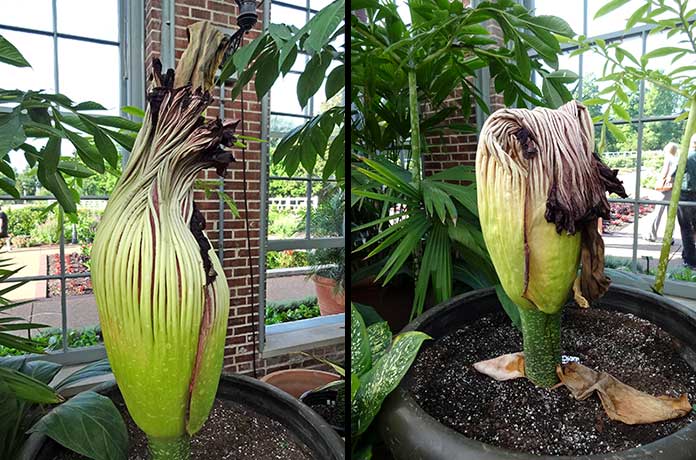 Collapse of the Amorphophallus Titanum (July 5, left; July 9, right)
Collapse of the Amorphophallus Titanum (July 5, left; July 9, right)
This morning the Titanum Amorphophallus named ‘Izzy’ is closed tightly. Its top is withering fast after blooming on Monday night. The botanical garden stayed open on Monday until 2 a.m. to accommodate the crowds. One of the keepers of the Titan said the lines to see it blooming stretched from the garden entrance out to the parking lot. At the height of the frenzy and the odor, visitors had a wait of an hour to hour and a half, she said.
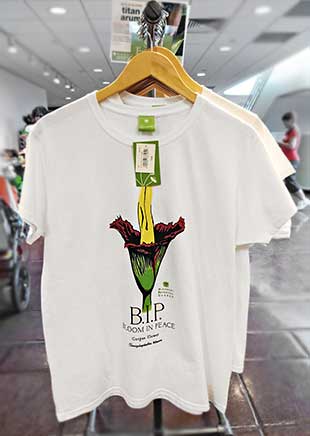 As a memento of the event, the botanical garden had t-shirts for sale with a picture of the blooming Titan and the phrase ‘Bloom in Peace.’ Izzy had a tuber that weighed in at 40 pounds and at when it was in full bloom, its spike of flowers was 62 inches tall.
As a memento of the event, the botanical garden had t-shirts for sale with a picture of the blooming Titan and the phrase ‘Bloom in Peace.’ Izzy had a tuber that weighed in at 40 pounds and at when it was in full bloom, its spike of flowers was 62 inches tall.
The price of quality hostas being sold in the gift shop of botanical garden continues to drop. Last week they were 25% off. This week it’s 40%. There are still many, many named varieties left though and some of them are being to show some shop stress.
At 40% off I decided to buy a couple. I bought a variety named ‘Cooltini’ marked down from $13.99. I wanted a blue, small to medium sized-leaved variety that didn’t grow too tall or spread too much to plant near my front entrance. ‘Cooltini’ fits. There’s a bonus too. The leaf stocks are dotted with maroon-colored splotches.
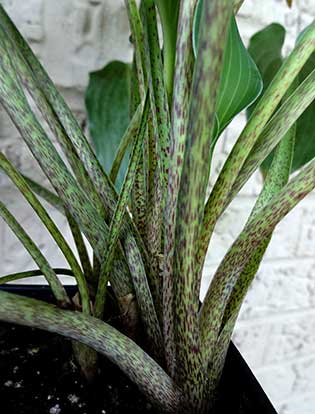 After I bought the plants, I looked for more about them on the web. ‘Cooltini’ was developed by Mark Zilis, author of mammoth definitive guide to everything hosta – The Hostapedia: An Encyclopedia of Hostas. ‘Cooltini’ is one of a series of 13 hostas with names that end in –tini. There’s ‘Martini’ and of course, but also ‘Sakitini’ and ‘Cupatini.’ They’ve all been developed and are being sold by Q&Z, a wholesale hosta nursery.
After I bought the plants, I looked for more about them on the web. ‘Cooltini’ was developed by Mark Zilis, author of mammoth definitive guide to everything hosta – The Hostapedia: An Encyclopedia of Hostas. ‘Cooltini’ is one of a series of 13 hostas with names that end in –tini. There’s ‘Martini’ and of course, but also ‘Sakitini’ and ‘Cupatini.’ They’ve all been developed and are being sold by Q&Z, a wholesale hosta nursery.
The social media of hosta fans are not enamored by any of the –tinis. Too many varieties they say: “They actually annoy me. I really don’t think they have anything unique to offer and there are soooo many of them.” Others wonder if they’re all just a bunch of random seedlings without any real merits and the whole bunch of –tinis are just “mediocre plants introduced to create a catchy themed line of plants to sell, not because the plants are great.” Meanwhile my ‘Cooltinis’ have been planted near my front door. They’re growing nicely, unmindful of their web-knockers.
 New to me – this blue-leafed variant of Fothergilla named ‘Blue shadow.’ At this time of year all the other Fothergillas have pretty ordinary-looking green leaves. I’ve always thought of Fothergillas as being two-season shrubs. In spring they’re covered with tufts of sweet-smelling white flowers that bloom before the most of their leaves come on. Then in the fall all of their ordinary looking green leaves switch to intense shades of yellows, reds, and oranges. With ‘Blue Shadow’ now in the mix, there’s another season of interest.
New to me – this blue-leafed variant of Fothergilla named ‘Blue shadow.’ At this time of year all the other Fothergillas have pretty ordinary-looking green leaves. I’ve always thought of Fothergillas as being two-season shrubs. In spring they’re covered with tufts of sweet-smelling white flowers that bloom before the most of their leaves come on. Then in the fall all of their ordinary looking green leaves switch to intense shades of yellows, reds, and oranges. With ‘Blue Shadow’ now in the mix, there’s another season of interest.
 Often the choice of plants in this botanical garden startles me. The keepers of this garden have a talent for using fairly ordinary plants in ways I never would have imaged. Take a close look at the plants being used for the edging of the beds outside the Linnean glasshouse. Because there are so many plants planted so close together I thought they were they were some kind of variegated liriope – a pretty common, inexpensive way to edge a bed or a walkway. Get closer. These are not liriope. The beds are lined with variegated yuccas (Yucca filamentosa) named ‘Color Guard.’ Nowhere have I ever seen these dramatic, commanding plants used as a simple edging plant. Yuccas are usually plants that stand alone. They seemed to have evolved to draw attention themselves with their circular shapes, their sharp pointed leaves, and with their tall stocks lined with cream-colored flowers. The ‘Color Guards’ planted here are still small. Who knows what will happen as they spread out and start to erupt with six-foot tall spikes? Should be interesting to see what these prima donnas that have been forced to be members of the chorus do.
Often the choice of plants in this botanical garden startles me. The keepers of this garden have a talent for using fairly ordinary plants in ways I never would have imaged. Take a close look at the plants being used for the edging of the beds outside the Linnean glasshouse. Because there are so many plants planted so close together I thought they were they were some kind of variegated liriope – a pretty common, inexpensive way to edge a bed or a walkway. Get closer. These are not liriope. The beds are lined with variegated yuccas (Yucca filamentosa) named ‘Color Guard.’ Nowhere have I ever seen these dramatic, commanding plants used as a simple edging plant. Yuccas are usually plants that stand alone. They seemed to have evolved to draw attention themselves with their circular shapes, their sharp pointed leaves, and with their tall stocks lined with cream-colored flowers. The ‘Color Guards’ planted here are still small. Who knows what will happen as they spread out and start to erupt with six-foot tall spikes? Should be interesting to see what these prima donnas that have been forced to be members of the chorus do.
